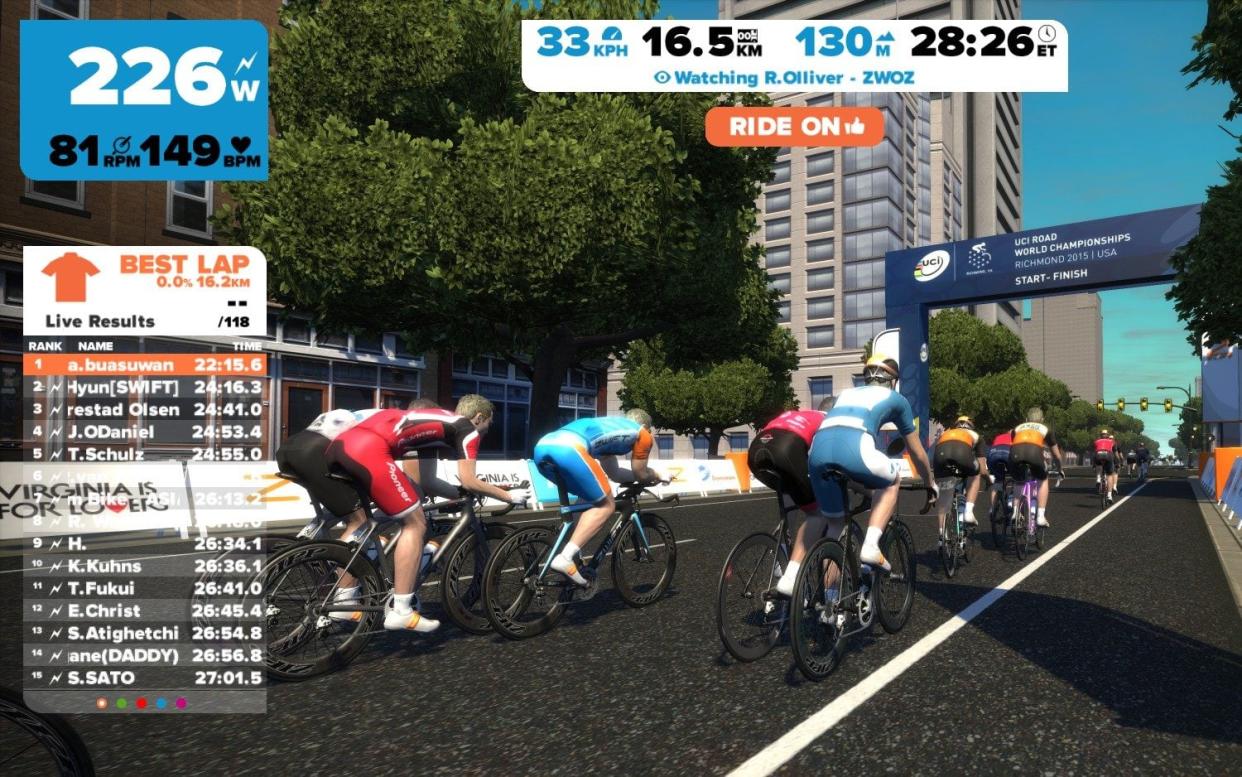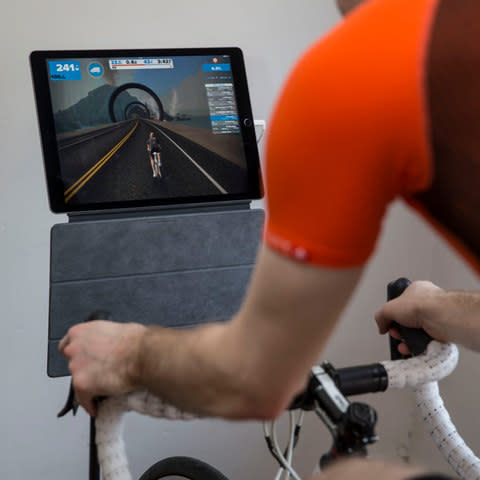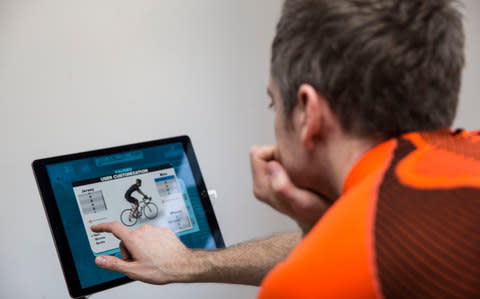Zwift: the story behind the indoor cycling phenomenon

As the winter nights draw in and cyclists dig out their indoor turbo trainers, the virtual reality training programme Zwift is helping to transform once monotonous indoor rides into a world of gaming, competition and social interaction.
The team behind Zwift talk to The Telegraph about reinventing indoor cycling and getting confused with Taylor Swift
Where did the idea for a virtual cycling programme come from?
Jon Mayfield (Co-founder): “I used to work in graphics engine programming for video game companies and I later worked for a think tank on big robots, global 3D visualisations and other amazing things for the (US) government. I was a busy dad and I wanted my cycle training to be fun and effective. So I started making simple 3D virtual power calculators and doing coding and cycling graphics in my spare time. I uploaded my work onto a web forum called Slow Twitch (in 2012) and then Eric got in touch (in 2013).”
Eric Min (Co-founder): “Before I met Jon I was building trading systems for virtual startups. I was a big cycling fan so the last thing I wanted to do was work in cycling. Passion start-ups rarely go well. But I knew a lot of people who spent hours training indoors and it was a pretty lonely experience. I had seen all the early concepts around 3D gaming and multi-player environments that had been around since the 1990s when the internet was barely available and technology was less advanced so the experience wasn’t great. But I was amazed nobody had revisited the concept for 25 years. Then I saw Jon’s project. I knew this guy was building something that could be the beginning of Zwift.”
How did your own personal cycling experiences influence the development of Zwift?
Jon Mayfield:“I was pretty new to cycling. I rode a bike but I wasn’t training as such. It really started when I became a dad and there was this big time crunch. I bought a trainer and after a few minutes of staring at the wall I was back at my computer searching on Google to find out how to make this not suck. I wanted to make it more motivational so you train harder and have a more fun social aspect.”
Eric Min: “My earliest memories of cycling are from when I was 13 years old and my high school friends introduced me to the sport. I lived north of New York and I was introduced to a club where the older kids took me to races. So for me the social aspect was a big thing.”
How did you turn the idea into a reality?
Eric Min: “We put a small team together in Long Beach in March 2014. Jon built something to show investors. After six months we went into a closed beta stage where we invited a number of users to help test it. We then had launches in London, New York and San Francisco and got brands like Pinarello into the game. We expected to launch with 700 testers but within the first ten days we had 13,000 requests so we knew right away this could be much bigger than we had ever thought.”
In which countries is Zwift most popular right now?
Steve Beckett (vice president marketing): “North America – the US and Canada – is about 30% of our market, then the UK is about 20% but we have users in over 150 countries. Bang for buck, Australia is our best market - they’re super-social and love the opportunity to feel connected to the rest of the world.”
How does the programme work?
Steve Beckett: “Anyone with a bike and indoor trainer can ride. If you have a classic trainer which may cost under £100 you really just require a speed sensor on your bike which communicates with a computer, iPhone or iPad and Zwift calculates your wattage based on your height and weight and your speed of pedaling. That figure translates into speed and movement around the virtual course. The premium option is a smart trainer which changes resistance as you go uphill or downhill and uses power output.”
The virtual world around which cyclists ride is called Watopia Island but you also feature real-life courses like RideLondon. In the future will we see more courses based on real places?
Jon Mayfield: “The island is already a fully immersive virtual landscape, with amazing details and changing weather – like snow in the mountains – and some new generation trainers even simulate the bumps from the cobbles. We will have a continuous stream of new content on a monthly or bi-monthly schedule. This month sees the launch of the Mayan Expansion (which takes riders through the Mexican jungle). But the key is to keep everybody together. We don't want 100 maps around the world and everyone spread across different virtual locations because then you miss the social element.”
Eric Min: “This is definitely something we have discussed. The problem is that some of the Tour de France routes might be fun outside but they are not necessarily the same fun inside. For example, 30 miles through the hills is nice outside but maybe not indoors. It might be that we have our own version of Alpe d’Huez. I’m not sure all the roads leading to Alpe d’Huez are that interesting so why would we want to recreate that? We can have more fun and challenging climbs. We can have an Italian village right next to a city like Miami. Like Disneyland, we can have lots of themed landscapes close together. If we can find a good course like our RideLondon map then great. We can make the virtual world better with slight tweaks and enhancements.”
Steve Beckett: “What we did with the RideLondon course was a hybrid approach so we gamified London. You could be in downtown London on the Strand and the Mall and then go to the Surrey Hills via the London Underground. That is how we struck a happy medium between real life and Watopia and that concept will be the mainstay of any route expansions. We would like to build a Classics-themed course, mixing all the delights of Amstel Gold, Liege-Bastogne-Liege and Flanders together along with some iconic hills.”

Will you introduce more gamification elements in the future?
Jon Mayfield: “Put it this way: there will not be baseball bats and weapons and things. People have asked about that but it’s not what we want. At the end of the day it’s about motivating people to train. What will it take to convince you to stay and ride indoors for an hour? All these gamification elements – like sprints and king of the mountains and rankings - mean you end up doing a harder workout without realising it. We might add elements like bike tag or capture the flag but we won’t be having weapons and things.”
Steve Beckett: “We want to be careful because a lot of cyclists – and our average user age is 38 – are playing their first computer game in 20 years. So we want enough reality to attract people to Zwift but once they get into it they get really hooked on the gaming. We get a lot of requests from our user base to develop courses like Rainbow Road – the course that was in the Mario Kart game.”
What do you think are the key factors in Zwift’s popularity?
Eric Min: “Most people enjoy the social aspect and the idea that you can enter this virtual world at any time of the day and race people you know or don’t know. This is a platform where we can simulate and replicate what we all enjoy about outdoor riding. We learned a lot from Strava – I am user number 13,000 which is pretty early as they started at number 5,000. I think with Strava you mostly compare with people you know. With Zwift it is a different dynamic and you race and encounter new people from all over the world.”
Jon Mayfield: “We have different types of users. The competitive guys love the races that have formed within the community. People create races and organise results. Maybe a quarter of users are like that. A lot of others are more casual social users. Then you also get the sort of athlete who might be following specific workouts from their coaches. I know one athlete whose coach logs in to watch him train on Zwift. He gets the live feed of numbers and can dial up on Skype and tell him to push harder. I am not a social rider on the roads but when I am by myself I like to know other people are suffering or having fun with me.”
Are professional riders using it too?
Eric Min: “100%. It turns out professional riders don't like training in the rain or the snow either. I think they also use Zwift as a media channel like Facebook, Twitter and Instagram. There are great stories already. Mat Hayman used it to get fit for Paris Roubaix after breaking his arm. We’ve now got some of the best triathletes out there using it as a training and recovery tool like Kona Ironman World Championships podium finisher Lucy Charles. There are more than 100 professionals on there and they bring real credibility in terms of how useful Zwift can be for training.”
Steve Beckett: “We were stoked to see Mark Cavendish appear on Zwift. He really embraces the fun community element and isn’t shy about posting his Zwifting on Instagram. Zwifting often feels a bit like playing in a pro-am golf tournament. You can go training but also get some fan engagement with pro riders. Louise Minchin the BBC presenter is a Zwifter and Darren Gough is a big fan also. It is a fun and social environment. Cycling can be cliquey with everyone looking at each other’s clothes but with Zwift we have all these animals in the jungle getting on fantastically well. We have over 100 Facebook groups and the biggest one is over 35,000 now.”
How important is the competitive element?
Eric Min:“The racing scene is pretty intense. We didn’t think racing would be a key focus but some of our live streamed races reach over 100,000 viewers. There’s a lot of scrutiny from our community and non-Zwift users about the authenticity of power numbers but there’s also a lot of self-policing in the community and race results are cross referenced against previous performances and outside data from Strava. At the end of the day Zwift should be about getting a great workout and training to be a stronger rider outdoors.”
Will Zwift branch into other sports?
Eric Min. “Yes, Zwift doesn't just talk about cycling. We left it open so we can entertain other verticals. We have running on the cards for next year. You can take a tablet to the treadmill and start running in the virtual world. I can see people meeting up for a group run at 7am. Running indoors is the next big thing and there is already evidence of studios in Manhattan dedicated to indoor running like group spin cycling sessions. We could also look into rowing and cross-country skiing and CrossFit. Zwift could be a digital destination for personal fitness. Imagine if that virtual world has people rowing along rivers while others are running and cycling along the roads and trails nearby.”
Steve Beckett: “We built the business around cycling in order to build the foundation but our ambition is to become an active lifestyle business. Across the board our users tend to be time-poor and goal driven, which is just as applicable to a pro triathlete or a busy parent. Running is also a natural extension. All you need is a foot pod – a sensor which sits on your trainers and cost £30-40 - and communicates to a computer or iPad which sits in front of you and you watch as you power your avatar in the game. We will look to build separate roads and move other sports like cross-country skiing or rowing. There are a million Concept 2 rowers in the world so that is another interesting option. We anticipate a growth in the gym and studio market as well as hotels. The $27 million we raised last November will be used to help us play on these broader playing fields.”

How did you come up with the name?
Eric Min: “The name was a process! We got through a lot of names. In my mind it had to be five letters and it had to be unique.”
Jon Mayfield:“I remember riding with some friends on Mount Baldy (in California) and running the names past them and I could only remember two of the eight candidates. But Zwift stuck in my head and that’s a good sign. After we named the company, Google would initially autocorrect to Taylor Swift. But now we’re there in our own right.”

